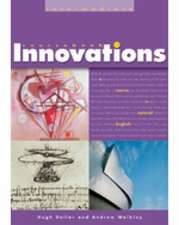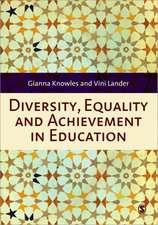What Successful Teachers Do in Diverse Classrooms: 71 Research-Based Classroom Strategies for New and Veteran Teachers
Editat de Neal A. Glasgow, Sarah J. McNary, Cathy D. Hicksen Limba Engleză Paperback – 22 mai 2006
A concise description of the recommended strategy
A brief synthesis of the research that supports use of the strategy
Guidelines for applying the strategy in the classroom
Precautions about avoiding pitfalls that may occur during implementation of the strategy
Source citations for further research and follow-up
This book will be an ideal companion title for teachers already using the authors' book on research-based strategies for working with special learners in inclusive classrooms.
| Toate formatele și edițiile | Preț | Express |
|---|---|---|
| Paperback (1) | 282.62 lei 6-8 săpt. | |
| SAGE Publications – 22 mai 2006 | 282.62 lei 6-8 săpt. | |
| Hardback (1) | 515.90 lei 6-8 săpt. | |
| SAGE Publications – 7 iun 2006 | 515.90 lei 6-8 săpt. |
Preț: 282.62 lei
Nou
54.08€ • 55.88$ • 44.99£
Carte tipărită la comandă
Livrare economică 20 martie-03 aprilie
Specificații
ISBN-10: 1412916178
Pagini: 192
Ilustrații: illustrations
Dimensiuni: 178 x 254 x 12 mm
Greutate: 0.41 kg
Ediția:1
Editura: SAGE Publications
Colecția Corwin
Locul publicării:Thousand Oaks, United States
Recenzii
"It has been a while since a useful book in the field of teaching diverse learners has come along and I can’t wait to share it with my faculty to allow every teacher to better accommodate our diverse learners...I love the clear organization and outline, as well as the reader friendly chapters with sources listed at the end of every chapter. The book provides teacher-friendly strategies that make it easy to accommodate the needs of diverse learners in every classroom. Finally, a book that shows every teacher ways to accommodate students with diverse learning needs! Thank you!"
"...the book address some very important topics that are at times difficult to even talk about let alone address in print."
"I have to admit this is one of the best three books I have ever reviewed for Corwin...coming from an urban environment, the authors have done a great job. This book is a wonderful contribution to the field."
"Right away, the importance of this book is established, since educators need to increase their MC knowledge due to changing demographics and rising expectations. Sarah McNary says it best when she states how there is no one definition of culture and no single technique that works every time. That sums up the complexity of this issue for educators"
Cuprins
Preface
Acknowledgments
About the Authors
Introduction
1. Making the Multicultural Connection
Strategy 1: Be sensitive to the diversity of today’s classrooms.
Strategy 2: Move beyond “color blind” teaching and take the time to know students in specific localized cultural contexts.
Strategy 3: Reflect on how multicultural competence is defined today.
Strategy 4: Help immigrant students by understanding their personal beliefs.
Strategy 5: White Ethnic students need multicultural education too.
Strategy 6: Cultivate multicultural connections.
Strategy 7: Develop and promote a positive ethnic identity to students.
Strategy 8: Watch for factors of exclusion that influence multicultural curriculum choices.
Strategy 9: Focus on the classroom management factors that best reflect culturally responsive teaching.
Strategy 10: Include multicultural works when developing a quality English curriculum.
2. Including Students with Special Education Needs
Strategy 11: Recognize that different cultures view disabilities differently.
Strategy 12: Teach all students about disabilities to facilitate the social acceptance of students with special needs
Strategy 13: Avoid excessive drill and repetition when teaching math.
Strategy 14: Spend more time teaching a few key concepts rather than trying to cover it all.
Strategy 15: Tailor homework to ensure success for students with disabilities.
Strategy 16: Spend the time to develop and use a variety of assessment strategies.
Strategy 17: Offer positive and constructive feedback rather than criticism.
Strategy 18: Communicate student progress early in a course, but avoid using formal grades to do so.
Strategy 19: Ensure students receive appropriate instructional or assessment accommodations.
Strategy 20: Be aware of potential bias when considering the recommendations of the Student Study Team
Strategy 21: Focus on classroom process before course content to increase time on task.
Strategy 22: Consider using Universal Design for Learning Principles when designing lessons.
Strategy 23: Encourage students to set process goals when learning new technology.
Strategy 24: Create scaffolds to help students learn complex skills and procedures
Strategy 25: Focus on instructionally centered communication when working with students with learning disabilities.
Strategy 26: Encourage students with disabilities to develop positive interpretations of their academic performance.
Strategy 27: Use instructional strategies that support the specific needs of students with attention deficit/hyperactivity disorder (ADHD).
3. Cultivating Gender Sensitivity
Strategy 28: Open the dialogue with students regarding gender equity issues.
Strategy 29: Support male and female students differently during school to school transitions as gender can influence their needs.
Strategy 30: Become aware of the traits of gifted females.
Strategy 31: Work to prevent inequities between male and female students’class partcipation.
Strategy 32: Consider how students sometimes treat female teachers differently than male teachers.
Strategy 33: Address gender issues in the classroom to increase student success and confidence.
Strategy 34: Be prepared for subtle gender bias in academic situations.
4. Including Students Who are Sexual Minorities
Strategy 35: Create a classroom environment of safety and respect.
Strategy 36: Access libraries to provide a more inclusive collection for sexual minorities.
Strategy 37: Explore curriculum that includes minority sexual identity and sexuality.
Strategy 38: Weigh the issues of choosing to remain “closeted” vs. “coming out” within educational settings.
Strategy 39: Consider the effect of teachers “coming out.”
Strategy 40: Be aware of the diverse and complex path that gay males undertake in self-defining themselves as gay.
Strategy 41: Work to prevent “low-level violence” in schools.
5. Supporting Students Who are Economically Disadvantaged
Strategy 42: Teach group skills to help low-income students establish a positive and encouraging support network to increase their likelihood of attending and completing higher education.
Strategy 43: Use cooperative test review and study guides to improve student achievement.
Strategy 44: Encourage all students to enroll in rigorous courses and build in the needed supports to facilitate their success.
Strategy 45: Utilize a variety of print materials to inspire student reading and writing.
Strategy 46: Explore the effects of pacing on student learning when working with low-income students.
Strategy 47: Teach self-regulation and attention sustaining skills to help students improve their performance.
Strategy 48: Explore team teaching to address the needs of economically disadvantaged students.
Strategy 49: Mentor economically disadvantaged students to improve their aspirations.
Strategy 50: Make academic success the first priority for economically disadvantaged students.
Strategy 51: Use a variety of assessments to identify gifted students from underrepresented groups, particularly economically disadvantaged students.
Strategy 52: Support equal access of extracurricular activities to promote student connectedness.
Strategy 53: Use popular films featuring urban classrooms as starting points for reflection and critical analysis.
Strategy 54: Be aware of the factors that contribute to the failure of highly competent students.
6. Meeting the Needs of English Language Learners
Strategy 55: Be wary of low expectations for language minority students.
Strategy 56: Reflect on the complex issues surrounding school literature selection for bilingual and bicultural students.
Strategy 57: Carefully consider the use of cooperative groups with second language students.
Strategy 58: Explore the definition of literacy and the complexity of the term when applied to bilingual and bicultural students
Strategy 59: Actively address the diverse needs of English learners.
Strategy 60: Prepare for a cultural and linguistic mismatch between teachers and their students.
Strategy 61: Select spell checker programs that meet the needs of the specific student population.
Strategy 62: Consider portfolios to create an overview of student performance and growth.
7. Working with Parents
Strategy 63: Develop strategies to help parents help their children succeed academically.
Strategy 64: Include parents from marginalized groups by making them feel welcomed.
Strategy 65: Involve minority and culturally diverse parents as resources in the classroom.
Strategy 66: Consider the positive and negative effects that homework has on students and their families.
8. Establishing and Sustaining Your Professional Identity
Strategy 67: Actively seek opportunities to expand personal experiences in multicultural settings.
Strategy 68: Internalize that cultural experience and perspective is different for each individual.
Strategy 69: Recognize the signs and symptoms of “diversity-related burn-out.”
Strategy 70: Successful teachers should become knowledgeable about adolescent culture.
Strategy 71: Do not underestimate the preparation necessary for placement in urban multicultural settings.
Index
Notă biografică
Neal A. Glasgow's experience includes serving as a secondary school science and art teacher both in California and New York, as a university biotechnology teaching laboratory director and laboratory technician, and as an educational consultant and frequent speaker on many educational topics. He is the author or coauthor of ten books on educational topics: What Successful Schools Do to Involve Families: Fifty Research-Based Strategies for Teachers and Administrators (2008), What Successful Literacy Teachers Do: 70 Research-Based Strategies for Teachers, Reading Coaches, and Instructional Planners (2007), What Successful Teachers Do in Diverse Classrooms: 71 Research-Based Strategies for New and Veteran Teachers (2006); What Successful Teachers Do in Inclusive Classrooms: 60 Research-Based Strategies That Help Special Learners (2005); What Successful Mentors Do: 81 Researched-Based Strategies for New Teacher Induction, Training, and Support (2004); What Successful Teachers Do: 91 Research-Based Strategies for New and Veteran Teachers (2003); Tips for Science Teachers: Research-Based Strategies to Help Students Learn (2001); New Curriculum for New Times: A Guide to Student-Centered, Problem-Based Learning (1997); Doing Science: Innovative Curriculum Beyond the Textbook for the Life Sciences (1997); and Taking the Classroom to the Community: A Guidebook (1996).






